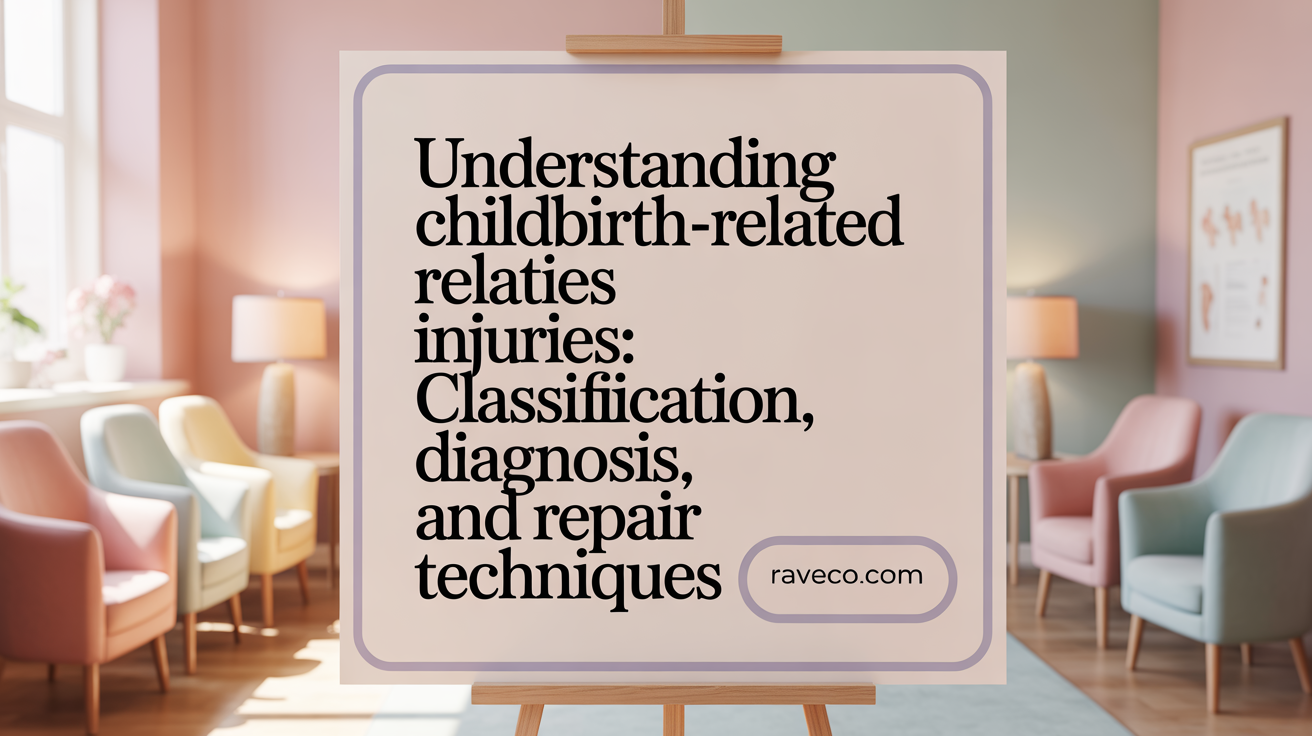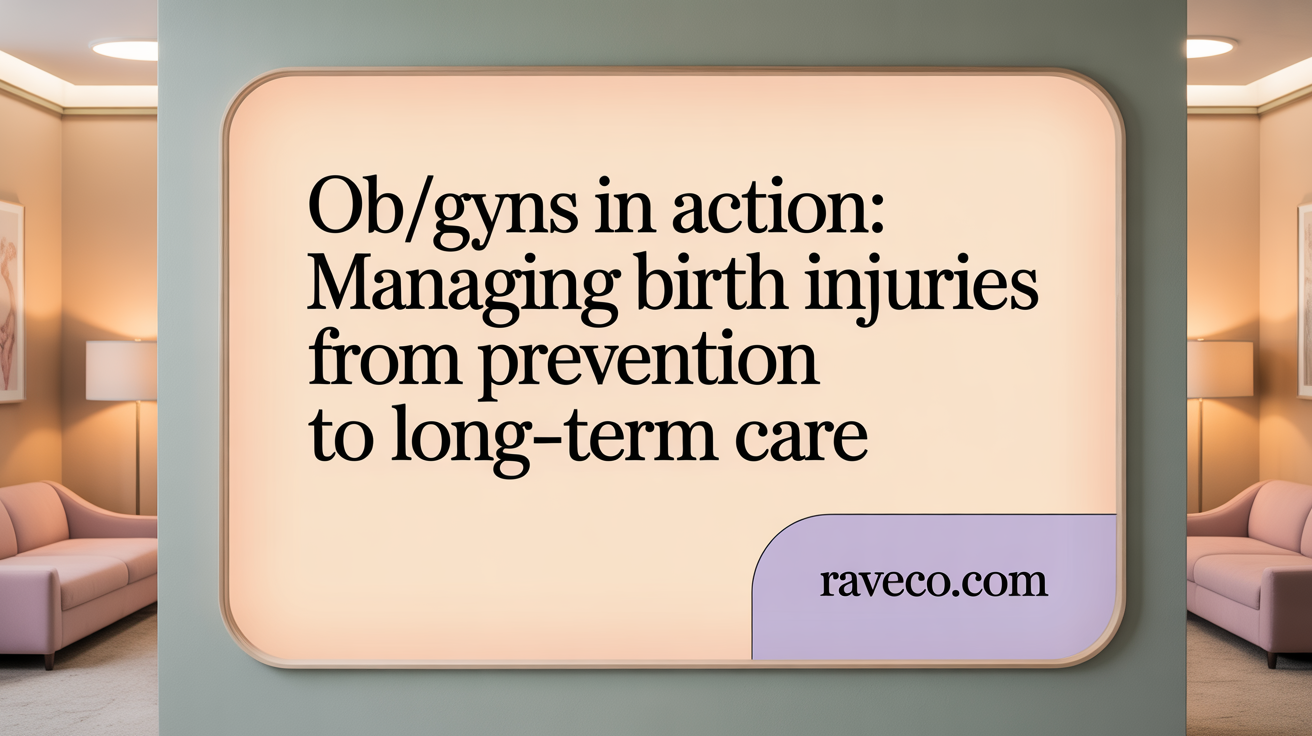Recognizing the Right Time to Address Female Infertility: Key Indicators and Expert Care in Queens

Understanding the Vital Role of OB/GYNs in Birth Injury Repair
Vaginal birth, while a natural and life-affirming process, often comes with challenges including perineal and pelvic floor injuries. Obstetrician-gynecologists (OB/GYNs) play a critical role in diagnosing, preventing, and repairing these injuries to ensure women’s physical and emotional well-being postpartum. This article explores the multifaceted involvement of OB/GYNs—from identification and surgical repair of obstetric lacerations to implementing evidence-based prevention strategies and guiding postpartum recovery.
Classification, Diagnosis, and Surgical Repair of Vaginal Birth Injuries

How are obstetric lacerations and perineal trauma classified, diagnosed, and managed?
Obstetric lacerations are classified into four levels based on severity:
- First-degree: Involve only the vaginal or perineal skin.
- Second-degree: Extend into the muscles of the perineum but do not involve the anal sphincter.
- Third-degree: Involve the anal sphincter complex, subdivided into partial or complete tears.
- Fourth-degree: The most severe, involving the anal mucosa as well as the sphincter muscles.
Diagnosis is primarily through careful clinical examination performed during and after delivery. Practitioners assess the wound visually and through digital rectal exams to determine the extent of tissue injury. Imaging tools such as ultrasound and MRI can support diagnosis, especially for subtle levator or pelvic floor injuries.
Management depends on the injury's degree. Most minor tears heal independently, requiring minimal intervention. Severe tears, classified as obstetric anal sphincter injuries (OASIS), necessitate precise surgical repair to restore the anatomy. Layered repair techniques ensure proper healing, and understanding the tissue reconstruction is vital to reduce the risk of complications like fecal incontinence.
What medical procedures and techniques do OB/GYNs use to treat vaginal birth injuries?
OB/GYNs employ varied surgical repair methods tailored to injury severity. For first- and second-degree tears, repair typically involves suturing the vaginal mucosa and underlying perineal muscles using absorbable sutures, performed immediately after delivery or in the delivery room.
In cases of third- and fourth-degree tears, a layered approach is critical. The surgical procedure involves carefully reapproximating the anal mucosa, internal anal sphincter, and external anal sphincter using specialized suturing techniques. Both end-to-end and overlapping repair methods are acceptable; however, overlap repairs are associated with lower rates of incontinence. Surgeons employ dissolvable sutures designed for tissues subject to movement and tension. Postoperative management includes pain control, wound care, and infection prevention—often using antibiotics, stool softeners, and careful hygiene.
These interventions aim to restore normal anatomy and function, minimizing long-term complications such as incontinence or chronic pain.
Roles and Responsibilities of OB/GYNs Throughout the Birth Injury Care Continuum

What are the roles and responsibilities of OB/GYNs in repairing vaginal birth injuries?
Obstetrician-gynecologists (OB/GYNs) are central to managing birth injuries associated with vaginal delivery. Their responsibilities span the entire spectrum of care, starting from prevention during labor to long-term patient follow-up.
During labor and delivery, OB/GYNs focus on minimizing injury risk by employing techniques such as perineal support, timely use of assistive devices like vacuum extractors, and considering strategies like early labor induction at 39 weeks. They are also trained to use evidence-based interventions like perineal massage and warm compresses to reduce the severity of tears.
Post-delivery, OB/GYNs are tasked with the assessment and diagnosis of any birth injuries. They perform thorough clinical examinations, including visual inspections and rectal exams, to identify tears ranging from first-degree to the most severe fourth-degree tears involving the anal sphincter and rectal mucosa. Advanced imaging modalities such as ultrasound and MRI can aid in diagnosing levator ani injuries and other soft tissue trauma.
For injuries requiring surgical intervention, OB/GYNs undertake precise repair procedures. These include layered suturing techniques to restore the integrity of the anal sphincter complex and vaginal tissues. The choice between repair methods, such as end-to-end or overlap repairs, is guided by the injury's specifics, with overlap repairs often associated with better incontinence outcomes.
Postoperative care is another crucial role, encompassing pain management, infection prevention with prophylactic antibiotics, and wound care to promote optimal healing. Long-term follow-up is essential to evaluate ongoing symptoms like incontinence, pain, or sexual dysfunction and to implement additional treatments such as pelvic floor physical therapy.
Ultimately, OB/GYNs aim to prevent injury where possible, accurately diagnose and repair injuries when they occur, and provide comprehensive care to enhance recovery and long-term health outcomes for women.
Prevention Strategies and Evidence-Based Best Practices in Vaginal Birth Injury Management

What are effective prevention strategies for vaginal birth injuries?
Preventing obstetric injuries begins before delivery, with strategies aimed at reducing tissue trauma during birth. Perineal massage during the third trimester can increase tissue elasticity, decreasing the likelihood of tearing. During labor, applying warm compresses to the perineum helps maintain tissue warmth and flexibility, which is associated with fewer severe lacerations.
Supporting women to relax their pelvic muscles during pushing—coached breathing and controlled delivery techniques—further minimize trauma. Selective use of mediolateral or lateral episiotomy in assisted vaginal births, especially in nulliparous women, can reduce the incidence and severity of tears.
Labor management techniques also play a crucial role. Slowing the delivery, performing manual rotation of the fetal head when malpositioned, and choosing maternal positions such as side-lying can decrease overstretching of tissues. Evidence-based guidelines from professional organizations like the American College of Obstetricians and Gynecologists (ACOG) underscore these interventions.
Combining these methods with ongoing clinician education creates a robust approach to minimize birth-related injuries and improve maternal outcomes.
What evidence-based guidelines and best practices guide OB/GYNs in managing vaginal birth injuries?
OB/GYNs are advised to avoid routine episiotomy, as research shows no maternal benefit and increased risks of postpartum complications such as anal incontinence. Instead, targeted support techniques—like warm compresses and perineal massage—are recommended to protect the perineum.
Accurate assessment and classification of tears during delivery facilitate appropriate repair. When severe injuries like obstetric anal sphincter injuries (OASIS) occur, layered repair using suitable suturing techniques and materials is essential for optimal healing. Prophylactic antibiotics, such as a single dose of IV amoxicillin and clavulanic acid, may reduce infection risk after extensive tears.
Post-repair care focuses on pain management, infection prevention, and functional monitoring. Continuous professional development through simulation training and quality improvement initiatives ensures clinicians maintain proficiency in diagnosing and repairing these injuries.
These evidence-informed practices collectively help reduce the incidence of severe birth injuries, promote better healing, and prevent long-term complications such as pelvic organ prolapse and incontinence.
More Information
For comprehensive guidelines and detailed strategies, refer to the ACOG practice bulletins and guidelines on vaginal birth injury prevention and management.
Comprehensive Postpartum Care and Follow-Up After Birth Trauma Repair

What does postpartum care and follow-up involve after birth trauma repair?
Postpartum management after repair of obstetric perineal trauma is essential for promoting healing and addressing long-term health issues. The initial focus is on controlling pain effectively and maintaining hygiene around the perineal area. Patients are encouraged to use sitz baths and ice packs to reduce swelling and discomfort. Over-the-counter pain medications are typically recommended to manage persistent soreness.
Monitoring for signs of infection, such as increased redness, swelling, foul discharge, or fever, is critical in the early weeks after delivery. Wound dehiscence—where the surgical repair opens—is also a concern and warrants prompt medical attention.
Preventative measures to avoid constipation are vital as straining can compromise healing. Stool softeners and a high-fiber diet help maintain regular, soft bowel movements, reducing the risk of wound disruption.
Follow-up visits generally occur between 6 to 12 weeks postpartum, allowing providers to assess healing, pelvic floor function, and resolution of symptoms like incontinence and pain during intercourse. Pelvic floor physical therapy can be beneficial, helping restore muscle strength and reducing scarring.
Addressing emotional health is equally important. Screening for postpartum mood disorders and providing psychological support or counseling as needed can enhance recovery.
Patients should be educated about warning signs such as worsening pain, persistent bleeding, signs of infection, or recurrent incontinence, which require timely medical evaluation. Ultimately, comprehensive postpartum care not only promotes physical healing but also supports mental and sexual health, ensuring long-term well-being after birth trauma repairs.
Significance of OB/GYN Expertise in Addressing Pelvic Floor Damage and Long-Term Outcomes
Obstetrician-gynecologists (OB/GYNs) play a vital role in diagnosing and managing pelvic floor disorders following childbirth. Their advanced training allows them to identify complex injuries such as levator ani muscle tears, vaginal wall defects, and obstetric anal sphincter injuries (OASIS). Utilizing state-of-the-art imaging techniques, including ultrasound and magnetic resonance imaging (MRI), OB/GYNs can accurately evaluate the extent and location of pelvic trauma, which is crucial for effective treatment planning.
Treatment options for pelvic floor injuries encompass both surgical and nonsurgical methods. Conservative therapies include pelvic floor physical therapy, which aims to strengthen muscles, improve function, and alleviate symptoms like incontinence and pelvic pain. Non-invasive measures such as pessaries may help manage prolapse. When necessary, surgical repairs—such as overlap or end-to-end sphincteroplasty for anal sphincter injuries—or prolapse surgeries help restore anatomy and function.
Pelvic floor damage significantly influences women’s quality of life, often leading to prolapse, urinary and fecal incontinence, pain, and sexual dysfunction. Early detection and prompt intervention are essential to prevent these long-term complications. OB/GYNs facilitate timely treatment to mitigate progression and improve outcomes.
Addressing pelvic health issues requires a multidisciplinary approach. OB/GYNs collaborate with pelvic floor physical therapists and mental health professionals to provide comprehensive care. Physical therapy helps rebuild pelvic muscle strength, while psychological support addresses emotional impacts, enhancing recovery and well-being.
Recognizing the importance of specialized expertise, early and coordinated intervention by OB/GYNs can decisively influence long-term health and quality of life for women affected by childbirth-related pelvic injuries.
The Critical Impact of OB/GYNs in Vaginal Birth Injury Care
OB/GYNs are indispensable in the continuum of care for vaginal birth injuries, from implementing preventive strategies during labor to performing intricate surgical repairs and providing holistic postpartum support. Their expertise not only restores anatomical and functional integrity but also safeguards women’s long-term pelvic health and quality of life. Ongoing education, adherence to evidence-based guidelines, and a multidisciplinary approach enhance outcomes, underscoring the vital role these specialists play in women's reproductive health after childbirth.
References
- Ob-Gyns Can Prevent and Manage Obstetric Lacerations ... - ACOG
- Perineal Lacerations - StatPearls - NCBI Bookshelf
- Obstetric Lacerations: Prevention and Repair - AAFP
- Birth Injuries (Perineal or Vaginal Tears) - UChicago Medicine
- Pelvic floor injury during vaginal birth is life-altering and preventable ...
- Pelvic floor injury during vaginal birth is life-altering and preventable
- Birth Injuries – Perineal (Vaginal) Tears - Baylor College of Medicine
- Prevention and Management of Obstetric Lacerations at Vaginal ...
- The prevention of perineal trauma during vaginal birth - ScienceDirect





.png)